Get ready to be amazed by the beautiful desert blooms, succulent floral wonders, and prickly petals. Have you ever thought about how cacti can bloom in harsh conditions? They show off their spiny splendor and resilient radiance.
From bright desert flowers to exotic succulent floral shows, cactus flowers are truly amazing. These drought-defying blossoms come in many colors, shapes, and smells. They adapt to survive in tough places. Get ready to see the arid beauty and spiny splendor of these tough plants as they celebrate life.
Captivating Cactus Blooms: A Journey into Desert Radiance
Cactus plants are known for their tough look, but they have a secret beauty. Their cactus with flower blooms come in colors like pink and orange. They stand out in the desert, showing off their arid beauty.
The cactus flower blooms at night, making it special and short-lived. These desert blooms only show up once a year. They prove how tough cacti are, surviving in tough places by storing water and nutrients.
The cactus flower shows us how to overcome hard times. Its beauty comes from a tough outside, like us finding strength inside. These prickly petals teach us about lasting through tough times and finding our inner strength.

In deserts from western Canada to Patagonia, cactus with flower varieties amaze us. Prickly pears, barrel cacti, and chollas make the desert beautiful. These flowers draw bees, butterflies, and hummingbirds, showing how life thrives in dry places.
The cactus flower’s ability to survive harsh conditions teaches us about being strong. Seeing these vibrant cacti with their prickly petals reminds us of our own strength. We can overcome tough times, just like these flowers do.
The Prickly Wonders of Opuntia: Prickly Pear Cacti in Bloom
Get ready to be amazed by the Opuntia genus. These tough and varied prickly pear cacti cover the Americas. They’re famous for their beautiful cactus flowers. These flowers come in bright yellow, orange, and pink, turning the desert blooms into a stunning show.
The opuntia cacti start blooming in mid-to-late May. This is when the sun makes their succulent floral wonders open up. These flowers don’t last long, but they attract many bees looking for pollen.
| Prickly Pear Cactus Variety | Flower Color |
|---|---|
| Black Knight | Magenta |
| Eastern Prickly Pear | Bright Yellow |
The Black Knight variety has purple paddles and magenta flowers. The Eastern Prickly Pear has bright yellow flowers that turn into red, edible prickly pears. These prickly pear cacti are a diverse and magical sight. They do well in xeriscape gardens and even under pine trees, making them great for gardeners who want plants that are easy to care for and can handle drought.
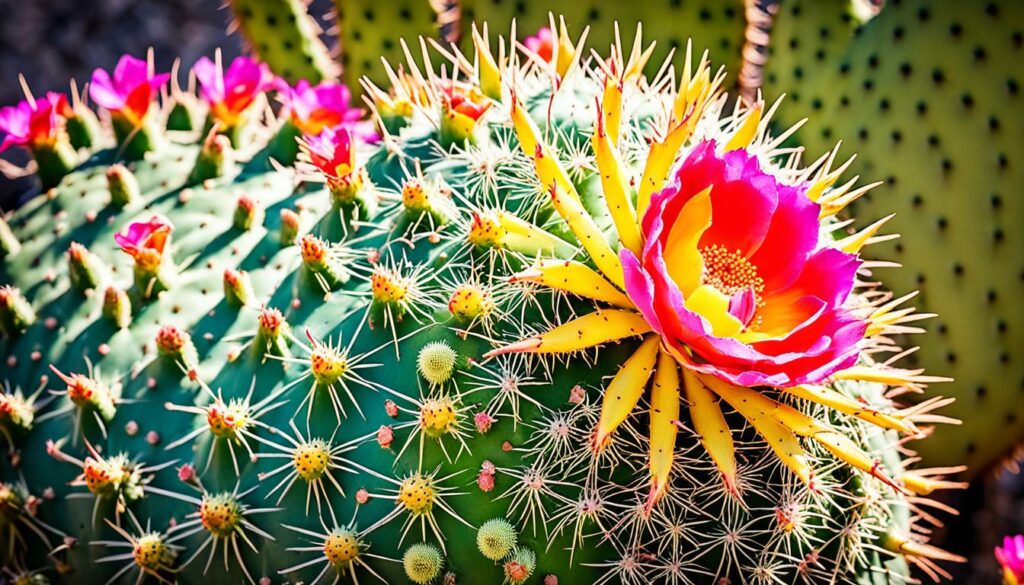
If you’re at the Arizona-Sonora Desert Museum or Saguaro National Park, you’ll see the amazing cactus flowers of the Opuntia genus. These prickly plants are a sight to behold. They have been loved by nature lovers for many years.
Holiday Cacti: Schlumbergera’s Colorful Seasonal Spectacle
The Schlumbergera genus, known as holiday cacti, are popular houseplants. They are famous for their bright flowers. From the Thanksgiving cactus to the Christmas cactus and the Easter cactus, they come in red, white, and pink colors. These plants are easy to care for and can brighten up your home during the holidays.
Thriving in Tropical Conditions
Holiday cacti live in the mountains of Brazil, at 3000 – 5000 ft high. They love the wet season’s 2-3 inches of rain each month. They need bright, indirect light or light shade, but can’t handle frost. The ideal temperature for them is 75-80°F during the day.
These cacti grow fast and can be fed like regular houseplants. Use a good-quality fertilizer, like a 10-10-10 mix, once a month.
Diverse Bloom Time and Varieties
There are three main types of holiday cacti: the Thanksgiving cactus, the Easter cactus, and the Christmas cactus. Each type blooms at different times, adding cheer to your home all year.
The Christmas cactus can live up to 20 years with the right care. It comes in many colors like red, purple, orange, pink, and white. To make it bloom more, keep the temperature between 55º – 65º. Also, change the light to 10 hours of light and 14 hours of darkness for four to six weeks after it starts growing new leaves.
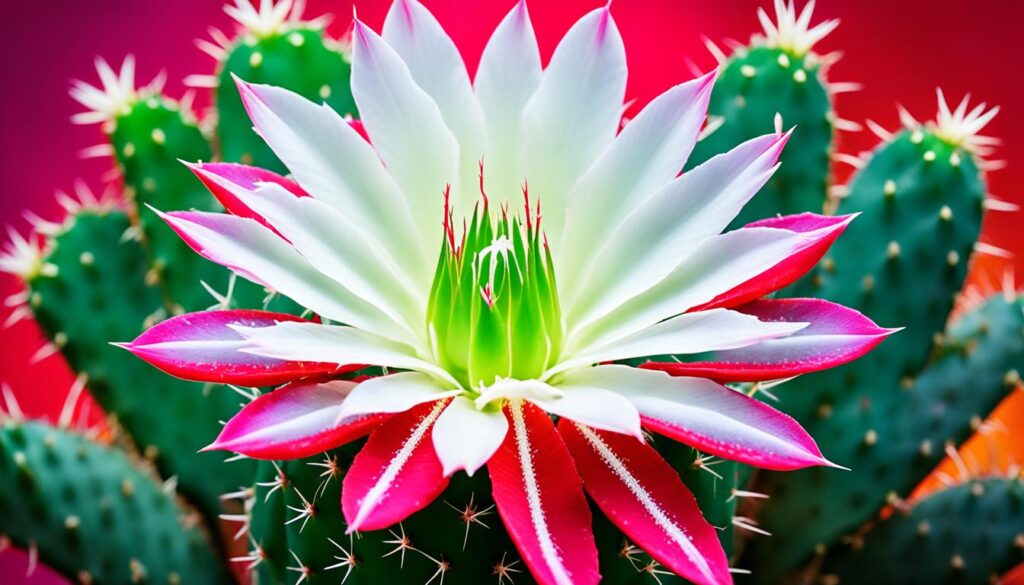
Decorating for Thanksgiving, Christmas, or Easter? Holiday cacti are a great choice. They bring natural beauty and seasonal charm to your home.
Echinopsis: The Majestic Hedgehog Cacti and Their Ephemeral Flowers
Get ready to be amazed by the stunning blooms of Echinopsis, also known as hedgehog cacti. These South American natives are famous for their beautiful, short-lived flowers. They have hairy buds that open into stunning flowers, showing off their beauty for a short time.
The Echinopsis genus includes orb-shaped and cylindrical cacti, each known for its gorgeous, brief blooms. These flowers come in colors like pink and orange. Seeing these flowers is a treat for cactus fans and nature lovers.
| Echinopsis Species | Flower Color | Bloom Duration |
|---|---|---|
| Echinopsis eyriesii | White, pink, purple | 1-2 days |
| Echinopsis oxygona | Bright pink | 12-24 hours |
| Echinopsis pachanoi | White, yellow | 1-3 days |
| Echinopsis peruviana | White, pink, purple | 1-2 days |
Echinopsis blooms are both beautiful and short-lived. They last only a day or two. This makes them a challenge to see. Gardeners and photographers love the thrill of catching these flowers in time.

Echinopsis cacti show the strength and variety of cacti. From Echinopsis eyriesii‘s delicate pinks to Echinopsis oxygona‘s bright oranges, these cacti amaze and inspire everyone who sees their flowers.
Epiphyllum: The Orchid Cacti and Their Enchanting Night Bloomers
The Epiphyllum are known for their beautiful night flowers. They have orchid-like flowers that bloom at night. These night-blooming cacti fill the air with a sweet smell.
Witnessing the Exotic Nocturnal Display
Epiphyllum are loved for their sweet-scented, jungle-cactus flowers. These exotic flowers bloom under the moonlight. They can last for days, showing their beauty at night.
The cactus blooms come in many colors, like pink and orange. These orchid cacti are truly amazing.
| Epiphyllum Variety | Flower Size | Bloom Duration | Flower Color |
|---|---|---|---|
| Disocactus crenatus ‘Chichicastenango’ | 8 inches wide | 3 1/2 days | White |
| Epiphyllum oxypetalum (Queen of the Night) | 9 inches wide | 1 night | White |
| Disocactus anguliger (Zigzag or Fishbone Cactus) | 5-7 inches | 1 night | Pink, purple |
Whether you’re an expert or new to gardening, epiphyllum and their night-blooming flowers will amaze you. Discover the sweet-scented blooms of these jungle cacti. See nature’s exotic orchid-like flowers up close.
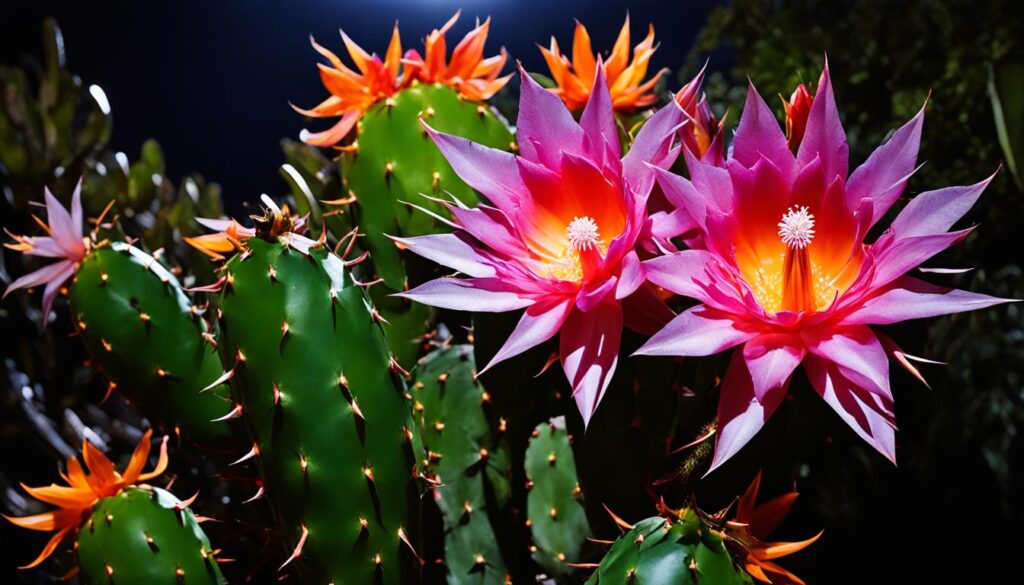
Rebutia: A Profusion of Petite Pink Flowers on Clustering Orb Cacti
Get ready to be charmed by the rebutia cacti. They are famous for their many small, pink flowers. These flowers grow on the plants in clusters and look like orbs. They bloom in spring, making a beautiful sight.
The rebutia group is perfect for anyone who loves plants with lots of colorful flowers. These clustering orb cacti come from Bolivia and Argentina. They live in dry places and show off beautiful flowers.
| Cactus Species | Bloom Time |
|---|---|
| The Little Mouse (Rebutia miniscula) | Mid-spring |
| The Scarlet Ball (Parodia haselbergii) | Late winter |
| The Monkey Tail Cactus (Cleistocactus colademononis) | Late spring to early summer |
If you love cacti or are just starting, the rebutia will amaze you. It has lots of pink flowers that grow on the plant’s orb-shaped parts. These bolivian and argentinian cacti are tough and look great.
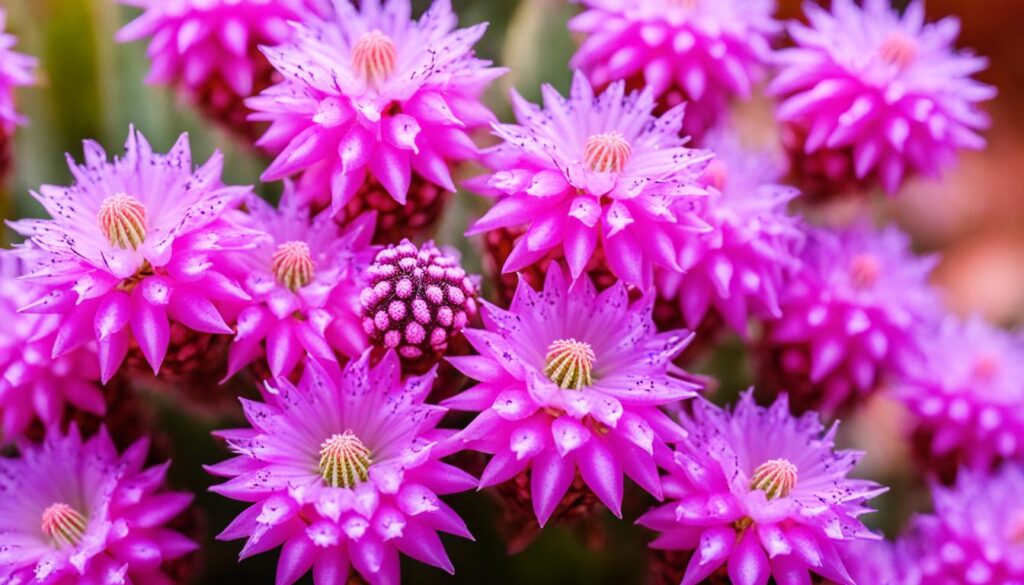
Astrophytum: Crown Jewels of the Desert with Regal Blooms
The Astrophytum genus is known as the «crown jewels» of cacti. They are loved for their orb-shaped forms and beautiful flowers. These plants from Mexico have blooms in yellow or cream that look like crowns on their plants. They are true desert gems, showing off their beauty with their summer flowers.
Orb-Shaped Cacti with Vibrant Crowns
Astrophytum cacti stand out with their orb-like shapes. They have vibrant crowns on top of their textured bodies. This makes them look regal and eye-catching. The astrophytum genus has many species, each with its own unique look.
| Astrophytum Species | Flower Colors | Distinguishing Features |
|---|---|---|
| Astrophytum myriostigma | Yellow, cream | Distinctive star-shaped patterns on the body |
| Astrophytum ornatum | Yellow, cream | Prominent ribs and tubercles on the body |
| Astrophytum capricorne | Yellow | Horns or «capricorns» on the body |
All astrophytum cacti produce stunning, regal blooms. These flowers crown the plant’s vibrant bodies. They are truly the «crown jewels» of the desert.
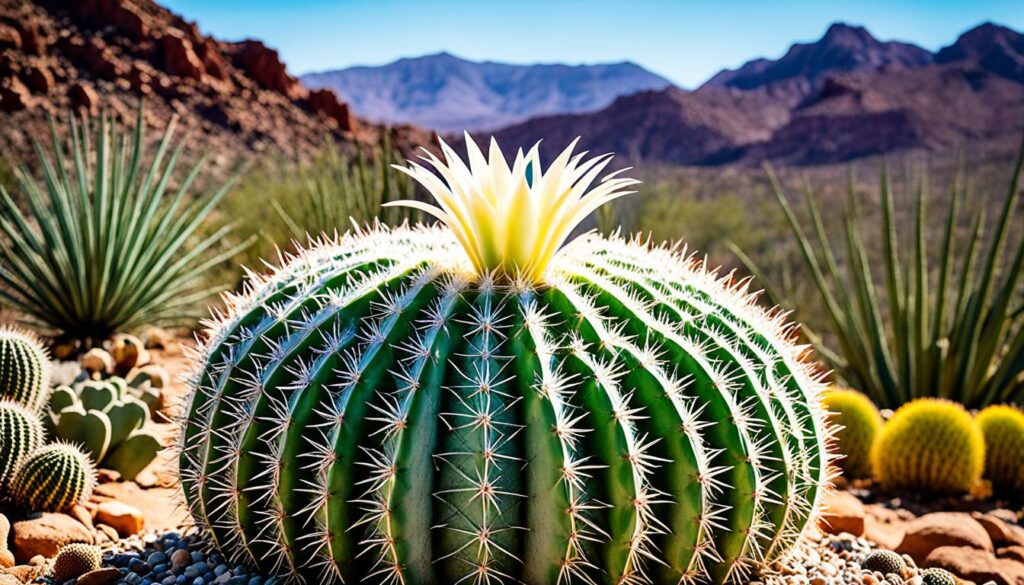
Mammillaria: A Genus of Globular Cacti with Magnificent Blooms
The Mammillaria genus is famous for its ball-shaped cacti and beautiful flowers. These small succulents are loved for their bright blooms in many colors. They show the beauty and variety in the cactus world.
These cacti come in many flower colors like pink, red, yellow, and white. Some grow alone, while others form groups. They do well in zones 9–11, liking warm temperatures and plenty of sunlight.
To make these cacti bloom, use a special cactus food once a year. Keep the humidity low and water them right, more in spring and less in fall. This helps them grow and bloom well.
| Mammillaria Cultivar | Characteristics |
|---|---|
| Mammillaria theresae | Only a half-inch tall and wide |
| Mammillaria compressa | Can grow over 1 foot in diameter and nearly 2 feet tall |
| Mammillaria elongata | Comes in several different colors and shapes, including a copper-spined version, a normal-spined version, a brain-shaped monstrose version, and a crested version |
| Mammillaria bocasana (Snowball or Powderpuff Fishhook Cactus) | Has fuzzy white hairs and flowers that are pale yellow with pink |
| Mammillaria decipiens var. camptotricha | Low-growing and prominently ‘nippled’ with long, curled spines that cross each other to form a bird’s nest look |
| Mammillaria geminispina | A variable species with forms having long or short spines, forming large clumps or smaller groups of plants, with pale yellow or pink flowers |
| Mammillaria hahniana ‘Superba’ | A mounding white fuzzy pile of cactus globes with brilliant pink flowers |
| Mammillaria longimamma | Known for having extra-large nipples, sparse thin spines, and large bright yellow flowers |
| Mammillaria matudae (Thumb Cactus) | A tall columnar species with short spines and a ‘halo’ of brilliant pink, closely spaced flowers near the top of each column |
With over 300 species, Mammillaria cacti offer many globular forms and beautiful blooms. Whether you like the fuzzy Snowball Cactus or the tall Thumb Cactus, this group has a lot to offer. They are perfect for anyone who loves mammillaria, globular cacti, cactus flowers, and magnificent blooms.
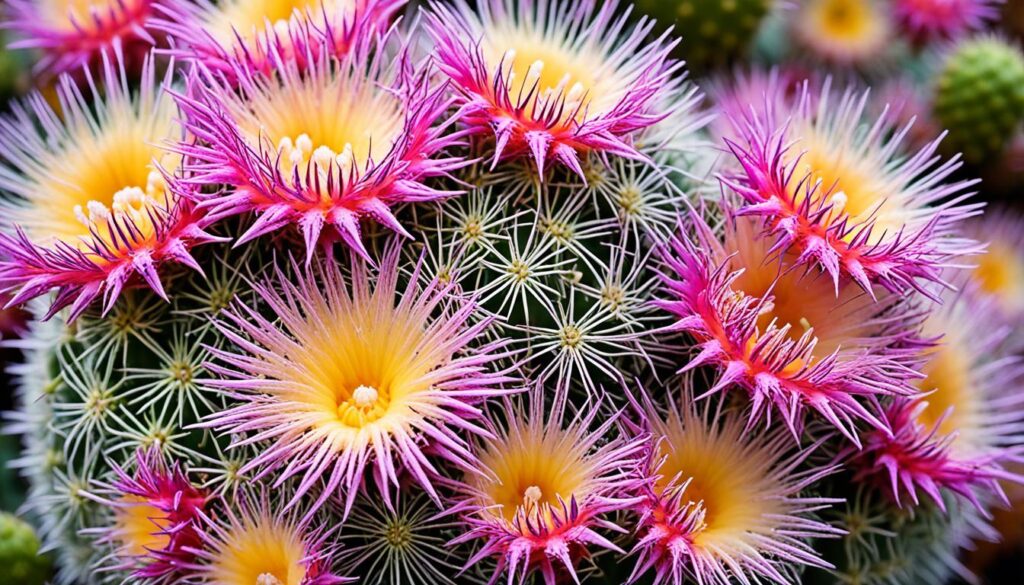
Selenicereus: The Dragons of the Cactus World with Night-Blooming Splendor
Get ready to be amazed by the Selenicereus genus, known as the «dragons» of cacti. They live in the jungle and include the famous pitahaya, or dragon fruit cactus, and the beautiful fishbone cactus. These cacti are famous for their huge, fragrant flowers that bloom at night. They light up the night with their beauty, making everyone who sees them feel special.
A Nocturnal Floral Display
The Selenicereus genus blooms at night. This happens when the temperature drops, humidity goes up, and certain chemicals are released. Their flowers can be up to 10 inches wide and come in many colors like white, yellow, pink, and red. They smell sweet and attract moths and bats, adding to the magical feel.

Selenicereus plants do more than just look beautiful. They clean the air by removing toxins like formaldehyde and benzene. They also have healing properties in traditional medicine, showing they could help us in new ways.
These plants look elegant and strong, symbolizing growth and beauty. They are easy to care for, making them perfect for both indoor and outdoor gardens. When their flowers turn into dragon fruit, or pitahaya, they become even more special, offering a tasty reward to their owners.
If you love their night-blooming flowers or their health benefits, the Selenicereus genus is a true wonder. It enchants everyone who sees its beauty.
Underrated Cactus with Flower Beauties: Opuntia, Neoporteria, and More
Many cacti have big, showy flowers that get all the attention. But, there are underrated cacti that have amazing flowers too. Opuntia, or prickly pear cacti, have bright cactus flowers. Yet, they often get lost in the crowd. The Neoporteria genus also has beautiful flowers that are often missed.
Let’s explore the hidden gems of the cactus world. We’ll see the variety of flowers that are not as well-known. From the soft colors of Opuntia flowers to the bright colors of Neoporteria, these underrated cacti show us that beauty is everywhere, even in the desert.
- Opuntia (Prickly Pear Cacti): These cacti have bright flowers in yellow, orange, and red. They are a favorite among cactus lovers.
- Neoporteria: This group has beautiful cactus flowers in pink and purple. They are often overlooked but are truly stunning.
- Other Overlooked Beauties: There are many other cacti with amazing flowers. Look for Gymnocalycium, Echinopsis, and Mammillaria to see their unique beauty.
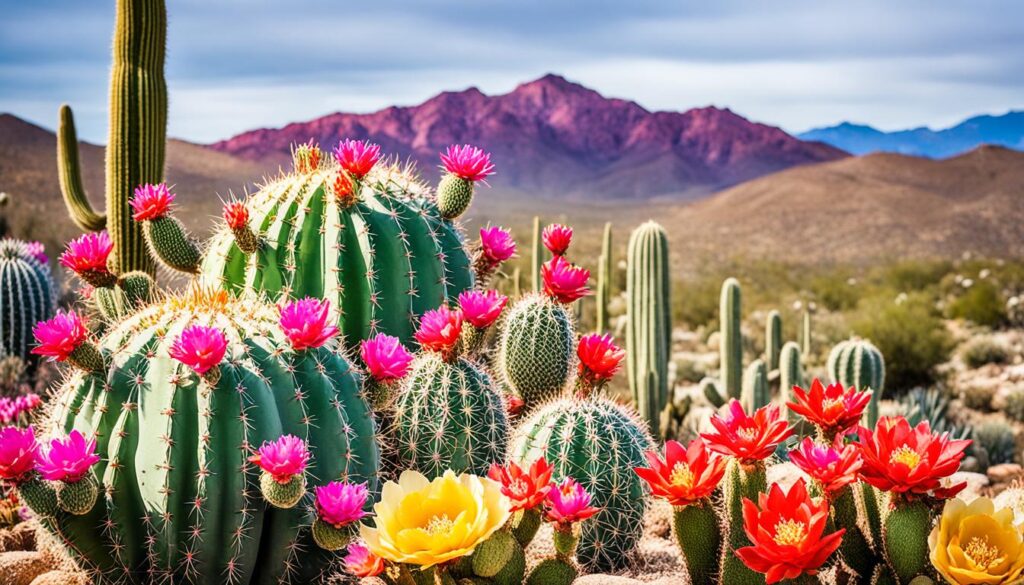
Let’s explore the secret world of cacti and find the overlooked beauties that are worth noticing. These underrated cacti with their beautiful cactus flowers show us how tough and diverse these plants are.
cactus with flower: Nature’s Resilient Blooms in the Desert
Cactus plants are known for their tough look and ability to live in tough places. They have a secret: many types have beautiful floral displays. These blooms come out in the desert landscape, showing off nature’s bright side. Let’s look at the different kinds of cactus flowers and how they can grow in tough places. They show the beauty of drought-tolerant wonders.
The Pinkflower Hedgehog Cactus shows the arid beauty of cactus flowers. It can store water and live in harsh desert places. This plant is important in Native American culture, seen as a symbol of human strength.
These cactus with flower types are important to their homes. The Pinkflower Hedgehog Cactus helps animals and plants live by providing food and shelter. It also helps save water, making it a good choice for gardens.
The strength and ability of cactus with flower species teach us about surviving hard times. They show us the power of nature’s quiet creatures. By enjoying these desert blooms, we learn more about nature and respect these drought-tolerant flowers.
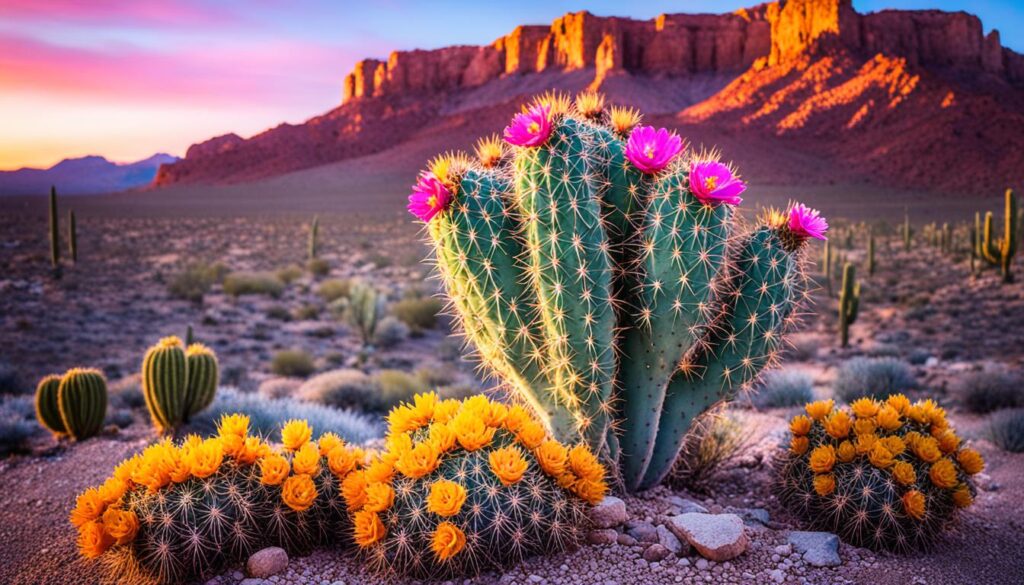
| Statistic | Value |
|---|---|
| Native American Culture | The Arizona Rainbow Cactus holds sacred significance in Native American culture, symbolizing endurance and adaptability. |
| Aesthetic Appeal | The vibrant colors of the Arizona Rainbow Cactus offer a visual treat in the desert, showcasing hidden beauty and diversity. |
| Environmental Awareness | The cactus plays a pivotal role in the desert ecosystem, supporting biodiversity and promoting ecological awareness. |
| Stress Relief | Studies suggest that cacti, like the Arizona Rainbow Cactus, can reduce stress levels and improve mood, contributing to mental well-being. |
| Educational Opportunities | The cactus serves as an educational tool, teaching students about desert ecology and connecting them to indigenous cultures. |
| Sustainable Gardening | Choosing the Arizona Rainbow Cactus for landscaping promotes sustainable practices, as it is drought-tolerant and eco-friendly. |
A Night to Behold: Capturing Ephemeral Cactus Blooms on Camera
Many cactus flowers bloom at night, showing off their beauty for just a short time. Photographers find it hard to capture these cactus flowers. Here are some photography tips to help you take amazing pictures of these desert plants.
Understand Blooming Patterns
Each cactus blooms differently. Some open in the late afternoon, others at night. Learn when your favorite cactus flowers bloom to plan your photoshoots.
Master Low-Light Photography
Photographing cactus flowers at night is unique. Try using long exposures, high ISO, and wide apertures. A strong tripod helps keep your camera still.
Be Prepared for Fleeting Moments
The blooms of many cacti don’t last long, sometimes just hours. Be quick and ready to capture cactus beauty before it’s gone. Make sure your camera is set and watch for the flowers to open.
With patience and the right skills, you can capture the beauty of night-blooming cacti. Embrace the challenge and let the desert’s secrets shine in your photos.

The Spiny Saguaro’s Elegant White Flowers: An Arizona Icon
The saguaro cactus is famous for its tall shape and spiky skin. But it also has beautiful, white flowers that grow on top. These iconic blooms are a special sight in Arizona. They show how the saguaro cactus is a symbol of the dry, southwestern land.
The saguaro cactus is more than just a pretty plant. It’s key to the desert’s life. Birds rely on it for food and homes. This shows how the Arizona desert’s creatures work together.
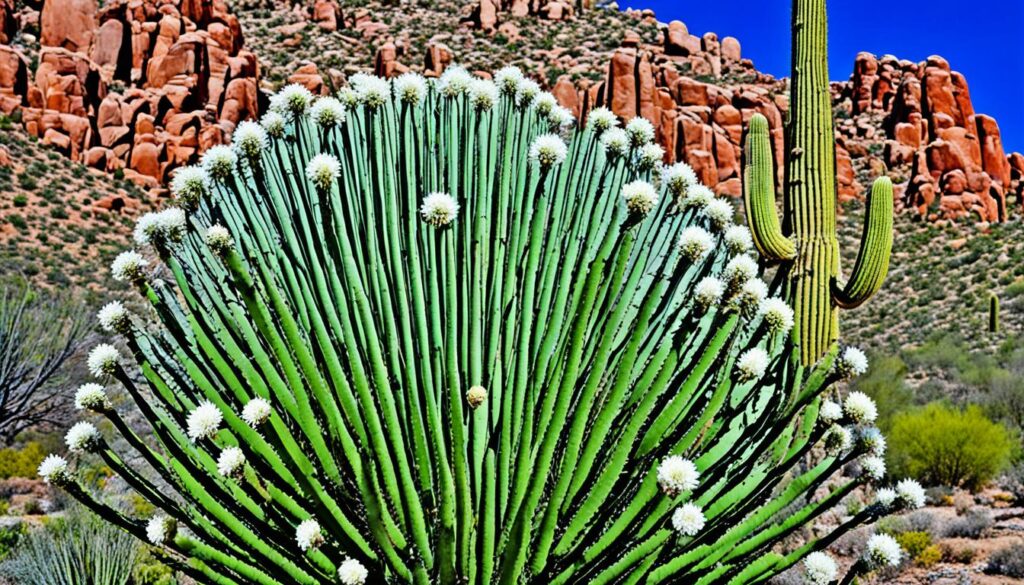
Seeing the saguaro cactus‘s flowers is amazing. These desert icons look tall and beautiful. Their white flowers move in the breeze. They show nature’s strength and beauty. The saguaro cactus and its flowers make a big impact, whether you’re close or just looking from afar.
Growing Cacti with Flowers: Tips for Unlocking Blooms Indoors
Cactus plants are often seen in the desert’s harsh landscape. But, many species can bloom indoors with the right care. Here are the key tips to make your potted cactus flower.
Providing the Right Conditions for Indoor Cacti Blooms
To make your indoor cacti bloom, focus on a few important things:
- Lighting: The Spiny pincushion cactus needs about five hours of direct sunlight daily. Peanut Cacti do well with 4 to 6 hours of sunlight indoors.
- Temperature: Keep the daytime temperature between 50 and 75 degrees Fahrenheit. At night, it should be cooler, 50°F to 65°F, for Peanut Cacti. This temperature change helps the cactus bloom.
- Soil and Drainage: Use a soil mix made for cacti with sand, perlite, and pumice for good drainage. Don’t use soil that stays wet, as it can cause root rot and stop blooming.
- Watering: Water your cacti deeply but don’t do it too often. Let the soil dry out between waterings. This helps prevent drought stress and helps the cactus flower.
- Fertilization: Feed your cacti with a special fertilizer for cacti and succulents. Use it when they’re growing to help them bloom.
With the right light, temperature, soil, water, and food, you can make your cactus show off its beautiful flowers.
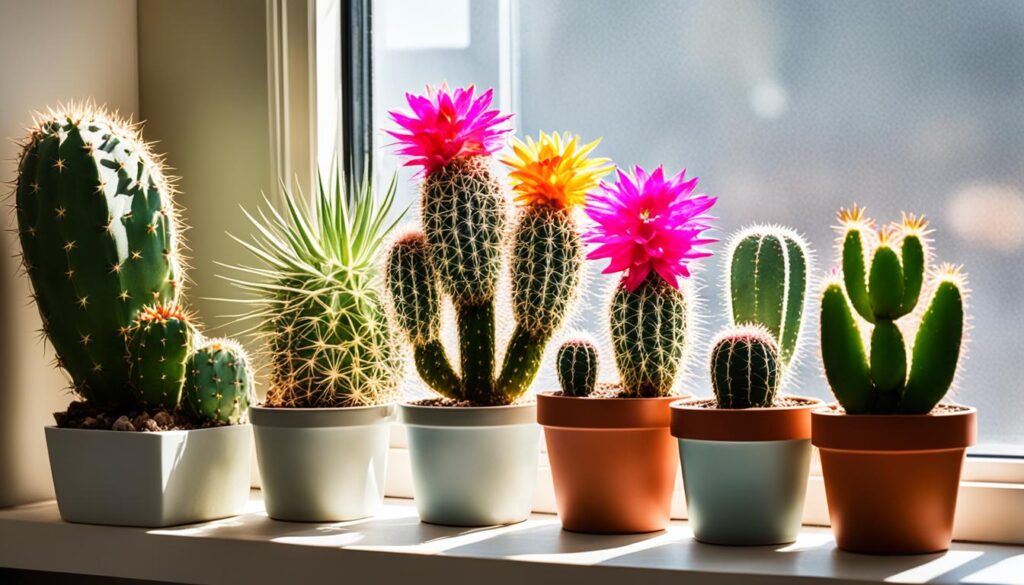
Troubleshooting Non-Blooming Cacti
If your indoor cacti aren’t flowering, there might be a few reasons:
- Not enough light: Make sure your cacti get the sunlight they need.
- Wrong watering: Change how often you water to avoid too much or too little water.
- Lack of nutrients: Use a fertilizer made for cacti to give them what they need to bloom.
- Stress from the environment: Changes in temperature, humidity, or other things can stop flowering.
Fix these issues and adjust the growing conditions to help your indoor cacti bloom and enjoy their beautiful flowers.
Beyond Thorns: The Diversity and Allure of Cacti Blooms
Cacti are known for their tough look, but they have a secret. Their flowers are a sight to see. They come in many colors, from soft pink to bright orange. These cactus flowers show how nature can be beautiful even in the desert.
Let’s look at the many types of cactus flowers. There are over 2,000 kinds, each with its own look and way of surviving. These flowers are more than just plants. They are symbols of strength, change, and mystery in many cultures.
The Saguaro cactus from the American Southwest and the Moon Cactus Flowers from South America are just a few examples. These cacti stand out with their unique shapes and colors. Let’s dive into the beauty of these plants that live in tough places.



